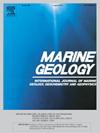Rapid retreat of marsh-edge cliffs, Jiangsu coast, China
IF 2.2
3区 地球科学
Q2 GEOSCIENCES, MULTIDISCIPLINARY
引用次数: 0
Abstract
Coastal salt marshes are an essential part of the ecosystem, but they are threatened by marsh-edge cliff retreat. Using satellite remote sensing and field data from 2013 to 2017, this study investigates the exceptionally high retreat rates of marsh-edge cliffs along the central Jiangsu coast of China, averaging 24.6 m/a (range: 7.3–39.2 m/a), which are an order of magnitude higher than typical global values. We examine the temporal and spatial patterns of cliff retreat and explore the mechanisms driving these rapid changes. Previous studies have widely considered wave power as the primary driver of marsh-edge retreat; however, this study shows that it cannot fully explain the observed rates. We identify two key factors contributing to the rapid retreat: (1) the open tidal flat environment, where strong tidal and coastal currents transport eroded sediment away, hindering sediment replenishment, and (2) the relatively tall marsh-edge cliffs with a substantial mesotidal range (∼3.4 m), which are more susceptible to erosion through cantilever failure and slumping. These findings highlight the complex interplay of environmental factors driving marsh degradation and suggest that future research should incorporate high-temporal-resolution monitoring to better capture the nature of cliff erosion, especially with increasing changes in climate condition globally.
沼泽边缘悬崖的迅速后退,江苏海岸,中国
沿海盐沼是生态系统的重要组成部分,但它们受到沼泽边缘悬崖退缩的威胁。利用2013 - 2017年的卫星遥感和野外数据,研究了中国江苏中部沿海沼泽边缘悬崖的异常高退缩率,平均为24.6 m/a(范围:7.3-39.2 m/a),比全球典型值高一个数量级。我们研究了悬崖退缩的时空格局,并探讨了驱动这些快速变化的机制。以前的研究普遍认为波浪能是沼泽边缘退缩的主要驱动力;然而,这项研究表明,它不能完全解释观察到的速率。我们确定了导致快速退缩的两个关键因素:(1)开放的潮滩环境,强烈的潮汐和海岸流将侵蚀的沉积物带走,阻碍了沉积物的补充;(2)相对较高的沼泽边缘悬崖,具有较大的中潮差(~ 3.4 m),更容易受到悬臂破坏和滑坡的侵蚀。这些发现强调了驱动沼泽退化的环境因素之间复杂的相互作用,并建议未来的研究应纳入高时间分辨率的监测,以更好地捕捉悬崖侵蚀的本质,特别是随着全球气候条件的日益变化。
本文章由计算机程序翻译,如有差异,请以英文原文为准。
求助全文
约1分钟内获得全文
求助全文
来源期刊

Marine Geology
地学-地球科学综合
CiteScore
6.10
自引率
6.90%
发文量
175
审稿时长
21.9 weeks
期刊介绍:
Marine Geology is the premier international journal on marine geological processes in the broadest sense. We seek papers that are comprehensive, interdisciplinary and synthetic that will be lasting contributions to the field. Although most papers are based on regional studies, they must demonstrate new findings of international significance. We accept papers on subjects as diverse as seafloor hydrothermal systems, beach dynamics, early diagenesis, microbiological studies in sediments, palaeoclimate studies and geophysical studies of the seabed. We encourage papers that address emerging new fields, for example the influence of anthropogenic processes on coastal/marine geology and coastal/marine geoarchaeology. We insist that the papers are concerned with the marine realm and that they deal with geology: with rocks, sediments, and physical and chemical processes affecting them. Papers should address scientific hypotheses: highly descriptive data compilations or papers that deal only with marine management and risk assessment should be submitted to other journals. Papers on laboratory or modelling studies must demonstrate direct relevance to marine processes or deposits. The primary criteria for acceptance of papers is that the science is of high quality, novel, significant, and of broad international interest.
 求助内容:
求助内容: 应助结果提醒方式:
应助结果提醒方式:


